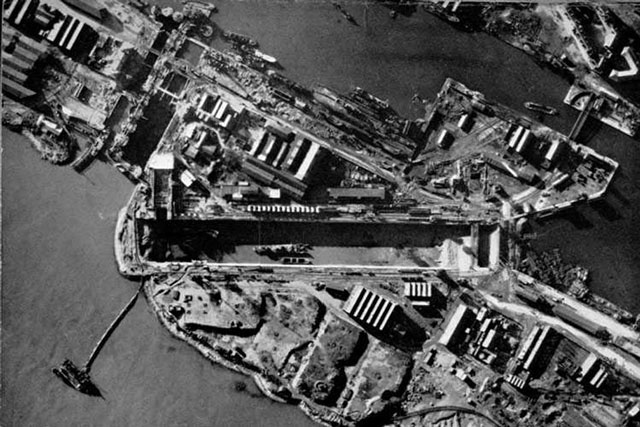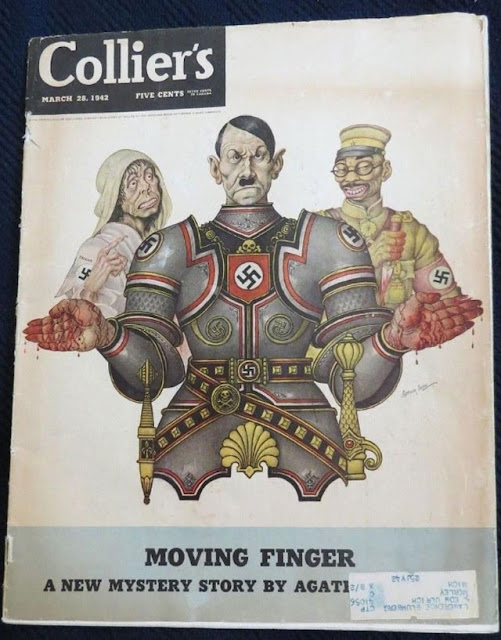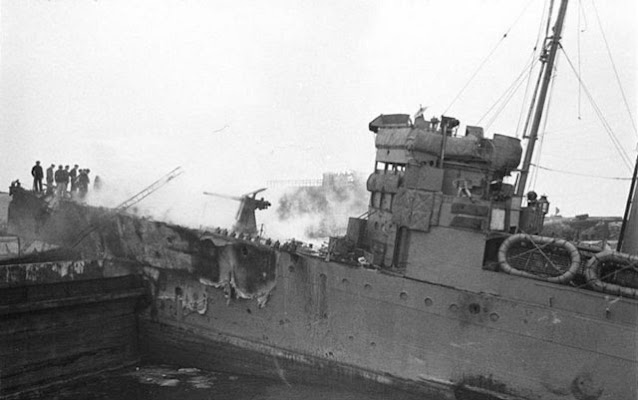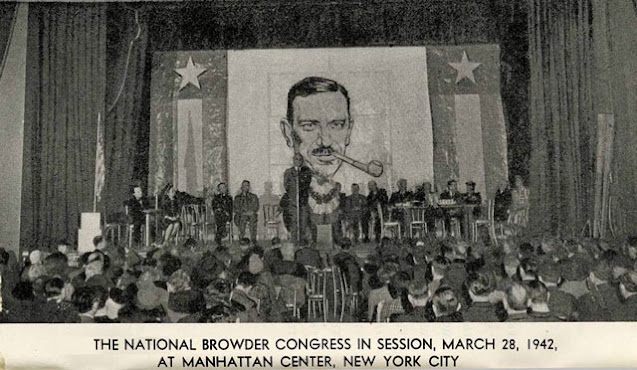Saturday 28 March 1942
 |
| The dry dock at St. Nazaire was the target of the 28 March 1942 raid by British Commandos. |
Special Operations: In Operation Chariot, British Commandos land in the early morning hours of 28 March 1942 at the French port of St. Nazaire, a major U-boat base. They almost experience disaster when key vessel HMS Campbelltown scrapes the bottom twice along the way but works its way loose. At about 01:30, the German defenders open fire with every weapon within range. Two assault teams, five demolition teams, and a mortar group disembark and help to silence some of the German fire. The navy then rams the Campbelltown into the large 'Tirpitz" dry dock that is the attack's main objective. It is packed with explosives controlled by a timer set to explode just after the British leave. As dawn approaches, the Commandos and navy withdraw as best they can. At noon, Campbelltown explodes (over seven hours late), destroying the dry dock, some nearby ships, and killing 360 men, including a large party of German officers on board to inspect the "captured" Royal Navy ship.
The St. Nazaire raid is a huge success for the British Commandos despite the force losing 394 of 622 men (169 killed, 215 taken prisoner). The dry dock is obliterated and 89 decorations including five Victoria Crosses (two posthumously). Adolf Hitler fires Generaloberst Carl Hilpert, chief-of-staff to the OB West (Commander in Chief West) and reinforces Hitler's growing insecurity (as evidenced by the 23 March 1942 Fuhrer Directive No. 40 entitled (somewhat prophetically) "Competence of Commanders in Coastal Areas") about the so-called Atlantic Wall.
 |
| Collier's of 28 March 1942 features a classic depiction of Adolf Hitler by artist Arthur Szyk. |
European Air Operations: Tonight's RAF Bomber Command target is Lübeck. While the RAF bombed Essen twice in the last three days, the bombers mostly missed that Ruhr Valley city and caused minimal damage. Lübeck, however, is a major port that is easier to locate. The 234 bombers (146 Wellingtons, 41 Hampdens, 26 Stirlings, and 21 Manchesters) have good visibility, including reflected moonlight off of ice near the city. Defenses at the city are light, allowing the bombers to drop to 2,000 feet, which greatly improves accuracy.
Attacking in three waves, the bombers drop over 400 tons of bombs aimed at the Altstadt central section of the town. The raid is an outstanding success for Bomber Command and causes the first firestorm in a German city. The medieval section of Lübeck is destroyed and many buildings of cultural significance are consumed by flames. There are about 320 deaths, 136 people seriously and 648 moderately injured, and 62% of the buildings in Lübeck are either destroyed or damaged. The RAF loses a dozen aircraft (7 Wellingtons, 3 Stirlings, 1 Hampden, and one Manchester).
There is only one consolation for the people of Lübeck, which is that the RAF never again sends a full-scale raid against the city. This is at least partly due to the port's use for the shipment of Red Cross supplies. As Joseph Goebbels writes in his diary:
The damage is really enormous. I have been shown a newsreel of the destruction. It is horrible. One can well imagine how such a bombardment affects the population.
It is clear to everyone that Lübeck Raid marks an ominous turn in the air war for the Reich.
In subsidiary air raids, two Blenheims attack targets in Holland (Schipol and Soesterburg), seven Hampdens lay mines in the Frisian Islands, and 14 bombers drop leaflets over France (9 over Paris, 5 over Lens) without loss.
Battle of the Pacific: The Japanese Imperial Guard completes Operation T (the occupation of Sumatra) when Dutch Major-General R.T. Overakker surrenders his 2,000 men near Kutatjane in North Sumatra. Tentative plans for a guerilla war collapse due to hostility from the native population and a Muslim uprising. The conquest of Sumatra has been a great victory for the Empire of Japan Vice-Admiral Jisaburō Ozawa, Rear-Admiral Shintarō Hashimoto, Rear-Admiral Kakaji Kakuta, Lt-Gen. Tomoyuki Yamashita, and Lt-Gen. Hitoshi Imamura.
General Overakker is one of the tragic figures of World War II. He does not survive the war because the Japanese shoot him and other Dutch officers in 1945 as defeat approaches. The Japanese force the captured Royal Netherlands East Indies Army (KNIL) soldiers to work on the construction of a railway line between Pekanbaru and Moera. This finds echoes in "The Bridge Over the River Kwai" (1957).
In Burma, the Japanese beef up their attacks against the Chinese defending Toungoo. The 3rd Heavy Field Artillery Regiment arrives and helps to break up Chinese resistance in various strongpoints. The Chinese are helped by heavy fog, however, that grounds Japanese bombers until after 15:00. The Japanese have sent for more reinforcements who arrive around noontime. These new troops attack from the east, which is the rear of the Chinese defenses, and a vicious fight takes place within the city itself. Ultimately, though, the Chinese defenders - who have nowhere to retreat - hold their ground. The Japanese forces are worn out by these failed attacks but continue attacking with declining force.
The British attempt to take some of the pressure off the Chinese at Toungoo by launching a relief attack that takes Paungde. Japanese troops consolidate nearby, however, placing the future of the attack in jeopardy.
Japanese bombers attack Darwin as they have several times already, but Allied air defenses are firming up. The P-40s of the 9th Pursuit Squadron, USAAF, shoot down three of the twin-engine bombers.
In the Philippines, the Japanese continue to bombard Allied forces in the Bataan Peninsula as they prepare for a final assault. The Japanese have reinforced the 14th Imperial Army under General Homma with heavy artillery that is focusing on Mount Samat in the center of the line.
Eastern Front: Two Finnish infantry battalions mop up Soviet holdouts on the island of Gogland in the frozen Gulf of Finland. In the very early morning hours, many of the remaining Soviet troops retreat back across the frozen ice. Some Soviet troops resist fiercely and force the Finns to use satchel charges to blast them out of their positions. The Finnish Air Force assists with the operation, proving especially handy at strafing Soviet soldiers attempting to retreat across the ice during daylight hours.
Fierce fighting continues northwest of Moscow at two separate pockets, one German and the other Soviet. General Seydlitz continues to grind toward the Demyansk pocket, while the German 18th Army is desperately trying to prevent the Red Army from opening a supply lane to the trapped men in the Volkhov pocket. The ongoing spring thaw is complicating both situations, turning the marshy ground into mush that slows all movement. Seydlitz regroups along the Redya River, while the Soviets use tanks to reopen a small supply corridor to their pocket. At the moment, it looks as if the Soviets are in a better position in both places, but the situation is precarious for both sides.
 |
| US Freighter Howick Hall, sunk south of Bear Island by the Luftwaffe on 28 March 1942. |
Battle of the Atlantic: German aircraft and U-boats begin attacking the Arctic Convoys with great ferocity recently as the hours of daylight increase. Many convoys have gotten through unscathed during the short winter days, but that is about to change. At sea is Convoy PQ-13. Luftwaffe aircraft spot the convoy today south of Bear Island and soon attack. The planes sink two freighters, 4815-ton Panamanian-flagged Raceland, 8097-ton US freighter Howick Hall, and 7008-ton British freighter Empire Ranger. Survivors of these ships sometimes have to row to shore, a brutal ordeal suffered by the men of the Howick Hall
The Kriegsmarine also gets into the fray with surface ships, a rarity even in the Arctic. Three German destroyers (Z24, Z25, and Z26) sortie from Kirkenes under the command of KzA G. Ponitz. The destroyers sink 4687-ton Panamanian-flagged freighter Bateau around midnight, but Royal Navy escorts spot them and set off in hot pursuit.
Battle of the Mediterranean: An Italian convoy from North Africa to Italy carrying a battalion of soldiers ordered to join the Italian Army in Russia runs into Royal Navy submarine Proteus (Lt Cdr Philip Stewart Francis) near Cape Ducali. The Proteus sinks 8040-ton Italian transport SS Galilea. There are 991 deaths and 284 survivors, the deaths including some Greek prisoners of war.
 |
| Pix Magazine, 28 March 1942. |
German/Japanese Relations: Despite the commitment of Japanese forces to the south against the British, United States, and the Netherlands, the Germans continue to hold out hope that they will assist in conquering the Soviet Union. Foreign Minister Joachim Ribbentrop asks Japanese Ambassador Oshima, considered a stalwart supporter of the Reich, to have his government commit forces to an attack north toward Vladivostok in conjunction with the Wehrmacht's upcoming "crushing blow" on the Eastern Front. Nothing comes of this, as Japanese ambitions currently extend not north into the Soviet Union, but west into the Indian Ocean.
Anglo/Indian Relations: The British publish a "Draft Declaration of Discussion, with Indian Leaders" simultaneously in Great Britain and India. This is the culmination of Sir Stafford Cripps' mission. The draft Declaration promises Dominion status to India that will provide equal status to India with "common allegiance to the Crown." The Indian nationalists, however, want something to happen immediately, not at some undetermined point after the war that may take quite some time to realize.
 |
| Pix magazine for 28 March 1942 includes a gripping story about the crew of a down Short Sunderland - with many photos, of course. |
US Military: Commander, Eastern Sea Frontier, US Navy acquires operational control of US Army Air Force bombers engaged in anti-submarine patrols off the East Coast of the United States.
The 4th Defense Battalion of the Marines arrives at Vila on Efate Island, New Hebrides. Their mission is to build an airstrip.
The USAAF 28th Bombardment Squadron (Heavy) transfers from Melbourne to Cloncurry, Queensland, Australia. Some operate out of Perth. The ground echelon remains trapped in the Philippines. Meanwhile, the 63rd and 65th Bombardment Squadrons complete their transit across the Pacific and arrive at Sydney, Australia. The 80th Pursuit Squadron, 8th Pursuit Group, transfers its P-39s from Brisbane to Lowood, Australia.
American Homefront: Stanford defeats Dartmouth 53-38 in the NCAA Basketball Tournament Final.
Future History: Neil Kinnock is born in Tredegar, Monmouthshire, Wales. He becomes a leader of the Labour Party. Among his top positions is serving as the Vice-President of the European Commission from 1999 through 2004. He also was Leader of the Labour Party from 1983 until mid-1992 and was introduced to the House of Lords on 31 January 2005. Neil Kinnock remains interested in politics as of this writing, including being strongly opposed to Brexit.
Gerald Eugene Sloan is born in McLeansboro, Illinois. He excels as a college basketball player and is picked by the Baltimore Bullets with the fourth pick overall of the 1965 NBA draft. Jerry Sloan ultimately plays most of his career with the Chicago Bulls before retiring in 1976 (and having his number retired). Sloan then goes on to an outstanding career as an NBA coach, compiling a 1221-803 record as a coach and leading the Utah Jazz to the playoffs to 15 consecutive playoff appearances from 1989 to 2003 before retiring in 2011. Jerry Sloan passes away on 22 May 2020.
 |
| The Saturday Evening Post for 28 March 1942 features the provocative article, "The Case Against the Jew" by Milton Mayer. |
March 1942
March 1, 1942: Second Battle of Java Sea
March 2, 1942: Huge Allied Shipping Losses at Java
March 3, 1942: Japan Raids Western Australia
March 4, 1942: Second Raid On Hawaii
March 5, 1942: Japan Takes Batavia
March 6, 1942: Churchill Assaults Free Speech
March 7, 1942: British Defeat in Burma
March 8, 1942: Rangoon Falls to Japan
March 9, 1942: Japanese Conquest of Dutch East Indies
March 10, 1942:US Navy attacks Japanese Landings at Lae
March 11, 1942: Warren Buffett's First Stock Trade
March 12, 1942: Japan Takes Java
March 13, 1942: Soviets Attack In Crimea Again
March 14, 1942: The US Leans Toward Europe
March 15, 1942: Operation Raubtier Begins
March 16, 1942: General MacArthur Gets His Ride
March 17, 1942: MacArthur Arrives in Australia
March 18, 1942: Japan Attacks In Burma
March 19, 1942: Soviets Encircled on the Volkhov
March 20, 1942: "I Shall Return," Says MacArthur
March 21, 1942: Germans Attack Toward Demyansk
March 22, 1942: Second Battle of Sirte
March 23, 1942: Hitler's Insecurity Builds
March 24, 1942: Bataan Bombarded
March 25, 1942: Chinese Under Pressure in Burma
March 26, 1942: Win Or Die, Vows MacArthur
March 27, 1942: The Battle of Suusari
March 28, 1942: The St. Nazaire Commando Raid
March 29, 1942: The Free Republic of Nias
March 30, 1942: Japanese-Americans Off Bainbridge Island
March 31, 1942: Japanese Seize Christmas Island



No comments:
Post a Comment